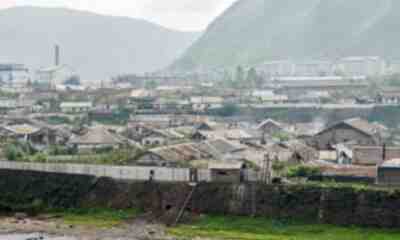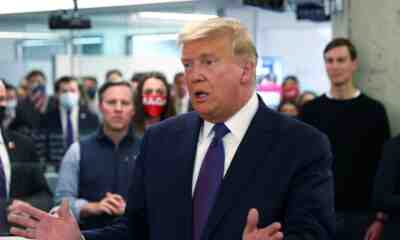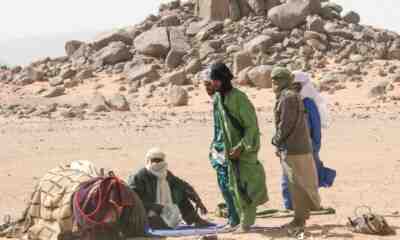Featured
Donald Trump começa a se reunir com Kim Jong Un
Compartilhe:

O presidente Donald Trump apertou as mãos e pareceu trocar gentilezas com o ditador norte-coreano Kim Jong Un na manhã de terça-feira, horário de Cingapura, dando início à cúpula histórica e antecipada dos dois líderes.
Espera-se que Trump e Kim passem aproximadamente 45 minutos em uma reunião individual, com apenas tradutores presentes, antes de participar de uma reunião mais ampla com mais funcionários de ambos os lados.
Donald Trump e Kim Jong-un começarão encontro histórico a sós
Autoridades dos EUA disseram que a Coréia do Norte deve se comprometer com a desnuclearização completa em troca de sanções, mas Trump disse que pode levar várias reuniões para garantir um acordo.
HISTÓRIA ANTERIOR
Na terça-feira, o presidente Donald Trump insultou os “inimigos e perdedores” que disseram ter criticado sua decisão de se encontrar com Kim Jong Un – insistindo apenas algumas horas antes da histórica reunião com o ditador norte-coreano de que os EUA já avançaram em seu relacionamento com o país. país e “vai ficar bem!”
“O fato de eu estar tendo uma reunião é uma grande perda para os EUA, dizem os odiadores e perdedores”, Trump twittou de Cingapura, que está hospedando o encontro. “Nós temos nossos reféns, testes, pesquisas e todos os lançamentos de mísseis pararam, e esses especialistas, que me chamaram de errado desde o começo, não têm mais nada a dizer! Nós ficaremos bem!”

O tweet seguiu um anterior, no qual Trump levantou esperanças e simultaneamente reconheceu a incerteza que cerca a cúpula, que poderia ajudar a definir sua presidência antecipada.
“Reuniões entre equipes e representantes estão indo bem e rapidamente”, Trump twittou, acrescentando: “… mas no final, isso não importa. Todos nós saberemos em breve se pode ou não acontecer um acordo real, diferente dos do passado! ”
Trump e Kim se encontrarão às 9h da manhã de terça-feira em Cingapura, 12 horas antes do horário do Leste, acompanhados inicialmente por tradutores, para o que poderia ser o momento mais dramático da presidência de Trump até o momento. Os dois homens viajaram em carreatas até o local da reunião, o resort Capella, na ilha de Sentosa, em Cingapura – uma viagem de 13 minutos para Trump.
Em questão está um programa nuclear norte-coreano que avançou pelo menos até a beira de atacar os EUA continentais, uma ameaça que Trump diz não tolerar. Politicamente, a cúpula é uma chance para Trump desempenhar o papel de estadista e negociador, desafiando os críticos que o consideram uma ameaça à estabilidade global e, pelo menos temporariamente, acalmando a fixação de Washington em seus laços com a Rússia.
Ainda não está claro se a reunião produzirá quaisquer promessas tangíveis – incluindo uma possível troca de garantias de segurança pelos EUA em troca de uma promessa de Kim de entregar seu arsenal nuclear. Trump sugeriu um possível acordo em que os EUA normalizam as relações com a nação pária de Kim se ela se desarmar. Os céticos temem que a cúpula possa produzir nada mais do que uma foto-operação que pouco faz para atrasar um possível conflito militar.
Trump se gabou na semana passada de que ele saberia “no primeiro minuto” se Kim está falando sério sobre obedecer às exigências dos EUA para acabar com seu programa nuclear. O presidente republicano, que chegou para a cúpula de um confronto amargo de fim de semana com aliados dos EUA no G-7, também descartou a necessidade de se preparar, dizendo que “atitude” é o que mais importa.
Muitos observadores esperam que Trump declare vitória, independentemente do acordo que ele possa fazer com Kim, considerado um dos ditadores mais repressivos do mundo. Mas alguns temem que a falta de preparo de Trump e seu desejo por uma vitória no cenário global o levem a oferecer concessões prematuramente, e que o líder norte-coreano aproveite o prestígio de estar na mesma sala que o presidente dos EUA.
“Não importa o que aconteça hoje, é uma vitória para Kim Jong Un”, disse Michael Auslin, membro da Hoover Institution. “Comparado a isso, há enormes riscos para Donald Trump”.
Trump, que faz 72 anos na quinta-feira, conquistou um tom confiante. “Ótimo estar em Cingapura, emoção no ar!” ele twittou após o desembarque. Na segunda-feira, ele almoçou com o primeiro-ministro de Cingapura, Lee Hsien Loong, onde recebeu um bolo de aniversário.
O normalmente recluso Kim, que raramente se aventurou fora da Coréia do Norte, visitou separadamente as ruas de Cingapura. Ele foi ladeado por diplomatas, seguranças e jornalistas enquanto caminhava pela cidade moderna e diversificada na segunda-feira à noite, horário local. O líder norte-coreano, por anos visto apenas em fotos encenadas pela mídia oficial de seu governo, chegou a posar para uma selfie com o ministro das Relações Exteriores do estado da Ásia do Sudeste Asiático. (Kim também se encontrou com o primeiro-ministro de Cingapura.)
ATUALIZAR
O presidente Donald Trump apertou as mãos e pareceu trocar gentilezas com o ditador norte-coreano Kim Jong Un na manhã de terça-feira, horário de Cingapura, dando início à cúpula histórica e antecipada dos dois líderes.
Espera-se que Trump e Kim passem aproximadamente 45 minutos em uma reunião individual, com apenas interpletes
Texto original
UPDATE
President Donald Trump shook hands and appeared to exchange pleasantries with North Korean dictator Kim Jong Un on Tuesday morning, Singapore time, kicking off the two leaders’ highly anticipated and historic summit.
Trump and Kim are expected to spend roughly 45 minutes in a one-on-one meeting, with only translators present, before participating in a broader meeting with more officials on both sides.
U.S. officials have said that North Korea must commit to full denuclearization in exchange for sanctions relief, but Trump has said it may take multiple meetings to secure a deal.
EARLIER STORY
President Donald Trump early Tuesday taunted the “haters & losers“ who he said have criticized his decision to meet with Kim Jong Un — insisting just hours before the historic summit with the North Korean dictator that the U.S. has already made headway in its relationship with the country and “will be fine!“
“The fact that I am having a meeting is a major loss for the U.S., say the haters & losers,“ Trump tweeted from Singapore, which is hosting the gathering. “We have our hostages, testing, research and all missle launches have stoped, and these pundits, who have called me wrong from the beginning, have nothing else they can say! We will be fine!“
The tweet followed an earlier one in which Trump raised hopes and simultaneously acknowledged the uncertainty that surrounds the summit, which could help define his early presidency.
“Meetings between staffs and representatives are going well and quickly,“ Trump tweeted, adding: “…but in the end, that doesn’t matter. We will all know soon whether or not a real deal, unlike those of the past, can happen!“
Trump and Kim will meet at 9 a.m. Tuesday in Singapore, which is 12 hours ahead of Eastern Time, accompanied at first only by translators, for what could be the most dramatic moment of Trump’s presidency to date. Both men traveled in motorcades to the meeting site, the Capella resort on Singapore’s Sentosa island — a 13-minute ride for Trump.
At issue is a North Korean nuclear program that has advanced at least to the brink of being able to strike the continental U.S., a threat that Trump says he will not tolerate. Politically, the summit is a chance for Trump to play the role of statesman and dealmaker, defying critics who call him a threat to global stability, and at least temporarily quiet Washington’s fixation on his ties to Russia.
It remains unclear whether the meeting will produce any tangible promises — including a possible exchange of security guarantees by the U.S. in return for a pledge by Kim to surrender his nuclear arsenal. Trump has suggested a potential deal in which the U.S. normalizes relations with Kim’s pariah nation if it disarms. Skeptics worry the summit could produce nothing more than a photo-op that does little to delay a potential military conflict.
Trump boasted last week that he would know “within the first minute” whether Kim is serious about obeying U.S. demands to end his nuclear program. The Republican president, who arrived for the summit fresh off a bitter weekend clash with U.S. allies at the G-7, has also dismissed the need to prepare, saying that “attitude” is what matters more.
Many observers expect Trump to declare victory regardless of what deal he can strike with Kim, who is considered one of the world’s most repressive dictators. But some worry that Trump’s lack of preparation and his desire for a win on the global stage will lead him to prematurely offer concessions, and that the North Korean leader will capitalize on the prestige that comes with being in the same room as the U.S. president.
“No matter what happens today, it’s a win for Kim Jong Un,” said Michael Auslin, a fellow at the Hoover Institution. “Compared to that, there are huge risks for Donald Trump.”
Trump, who turns 72 on Thursday, has struck a confident tone. “Great to be in Singapore, excitement in the air!” he tweeted after landing. On Monday, he had lunch with Singapore’s prime minister, Lee Hsien Loong, where he was given an early birthday cake.
The normally reclusive Kim, who has rarely ventured out of North Korea, separately toured the streets of Singapore. He was flanked by diplomats, security guards and journalists as he walked around the modern, diverse city on Monday night local time. The North Korean leader, for years seen only in photos staged by his government’s official media, even posed for a selfie with the Southeast Asian city-state’s foreign minister. (Kim also met with Singapore’s prime minister.)
UPDATE
President Donald Trump shook hands and appeared to exchange pleasantries with North Korean dictator Kim Jong Un on Tuesday morning, Singapore time, kicking off the two leaders’ highly anticipated and historic summit.
Trump and Kim are expected to spend roughly 45 minutes in a one-on-one meeting, with only translators present, before participating in a broader meeting with more officials on both sides.
U.S. officials have said that North Korea must commit to full denuclearization in exchange for sanctions relief, but Trump has said it may take multiple meetings to secure a deal.
EARLIER STORY
President Donald Trump early Tuesday taunted the “haters & losers“ who he said have criticized his decision to meet with Kim Jong Un — insisting just hours before the historic summit with the North Korean dictator that the U.S. has already made headway in its relationship with the country and “will be fine!“
“The fact that I am having a meeting is a major loss for the U.S., say the haters & losers,“ Trump tweeted from Singapore, which is hosting the gathering. “We have our hostages, testing, research and all missle launches have stoped, and these pundits, who have called me wrong from the beginning, have nothing else they can say! We will be fine!“
The tweet followed an earlier one in which Trump raised hopes and simultaneously acknowledged the uncertainty that surrounds the summit, which could help define his early presidency.
“Meetings between staffs and representatives are going well and quickly,“ Trump tweeted, adding: “…but in the end, that doesn’t matter. We will all know soon whether or not a real deal, unlike those of the past, can happen!“
Trump and Kim will meet at 9 a.m. Tuesday in Singapore, which is 12 hours ahead of Eastern Time, accompanied at first only by translators, for what could be the most dramatic moment of Trump’s presidency to date. Both men traveled in motorcades to the meeting site, the Capella resort on Singapore’s Sentosa island — a 13-minute ride for Trump.
At issue is a North Korean nuclear program that has advanced at least to the brink of being able to strike the continental U.S., a threat that Trump says he will not tolerate. Politically, the summit is a chance for Trump to play the role of statesman and dealmaker, defying critics who call him a threat to global stability, and at least temporarily quiet Washington’s fixation on his ties to Russia.
It remains unclear whether the meeting will produce any tangible promises — including a possible exchange of security guarantees by the U.S. in return for a pledge by Kim to surrender his nuclear arsenal. Trump has suggested a potential deal in which the U.S. normalizes relations with Kim’s pariah nation if it disarms. Skeptics worry the summit could produce nothing more than a photo-op that does little to delay a potential military conflict.
The most reliable politics newsletter.
Sign up for POLITICO Playbook and get the latest news, every morning — in your inbox.
Trump boasted last week that he would know “within the first minute” whether Kim is serious about obeying U.S. demands to end his nuclear program. The Republican president, who arrived for the summit fresh off a bitter weekend clash with U.S. allies at the G-7, has also dismissed the need to prepare, saying that “attitude” is what matters more.
Many observers expect Trump to declare victory regardless of what deal he can strike with Kim, who is considered one of the world’s most repressive dictators. But some worry that Trump’s lack of preparation and his desire for a win on the global stage will lead him to prematurely offer concessions, and that the North Korean leader will capitalize on the prestige that comes with being in the same room as the U.S. president.
“No matter what happens today, it’s a win for Kim Jong Un,” said Michael Auslin, a fellow at the Hoover Institution. “Compared to that, there are huge risks for Donald Trump.”
The White House said the expanded bilateral session would include Secretary of State Mike Pompeo, White House chief of staff John Kelly and national security adviser John Bolton. Joining for the working lunch will be White House press secretary Sarah Huckabee Sanders; Sung Kim, a U.S. ambassador with extensive North Korea experience; and Matt Pottinger, a top Asia hand on the National Security Council.
Bolton’s presence is noteworthy because he has angered North Korea by saying the U.S. should apply the “Libya model” to its negotiations with Pyongyang. Libyan dictator Moammar Gaddafi agreed in 2003-04 to get rid of his early-stage nuclear program in return for Western economic links, but he was killed nearly a decade later by rebels backed by the U.S. and its NATO allies.
Just months ago, a meeting between Trump and Kim would have seemed impossible. Trump in 2017 had ramped up sanctions and threatened to rain “fire and fury” on the isolated Asian country, derisively calling Kim “Little Rocket Man.” Kim, who is in his 30s, kept up his nuclear tests while belittling Trump as a “dotard.”
Trump also was especially angered when Otto Warmbier, a young American in North Korean custody, was returned to the United States in an unconscious state and later died.
Trump, who turns 72 on Thursday, has struck a confident tone. “Great to be in Singapore, excitement in the air!” he tweeted after landing. On Monday, he had lunch with Singapore’s prime minister, Lee Hsien Loong, where he was given an early birthday cake.
The normally reclusive Kim, who has rarely ventured out of North Korea, separately toured the streets of Singapore. He was flanked by diplomats, security guards and journalists as he walked around the modern, diverse city on Monday night local time. The North Korean leader, for years seen only in photos staged by his government’s official media, even posed for a selfie with the Southeast Asian city-state’s foreign minister. (Kim also met with Singapore’s prime minister.)
The White House said on Monday that pre-summit “discussions between the United States and North Korea are ongoing and have moved more quickly than expected.” But it also said Trump will leave Singapore late Tuesday, after talking to reporters — ruling out the possibility that the talks could be extended.
The Trump-Kim meeting is the first-ever session between a sitting U.S. president and a leader of North Korea. The two heads of state will meet one-on-one (with translators), before being joined by top aides and later sharing a working lunch.
In recent weeks, however, Pompeo has visited North Korea twice to talk to Kim about nuclear negotiations. North Korea also freed three other Americans in its custody — the hostages Trump referred to on Twitter — and it has taken other steps, such as dismantling a nuclear test site, that have sent positive signals to the United States.
Some analysts, however, questioned some of Trump’s claims in his latest tweet.
“Wait, all research had stopped? We have not verified that, [North Korea] has not declared it,“ wrote Jon Wolfsthal, a nuclear expert who served in the Obama administration. “The President does not even know the situation in the ground going into the summit. Inexcusable.”
Even though the two leaders are testing diplomacy, a substantive gulf appears to remain between them.
Trump aides use the phrase “complete, verifiable, irreversible denuclearization of the Korean Peninsula” to describe their aim. North Korea says it is committed to “denuclearization” of the peninsula as well. The key difference is that Pyongyang has traditionally defined “denuclearization” to include security guarantees from Washington that can include the removal of U.S. troops from South Korea and a pledge not to extend America’s nuclear umbrella over allies in the region.
Even if the two sides reach a common definition of denuclearization, how to achieve that goal — whether it involves tit-for-tat concessions, who will go first, and the time frame — still needs to be worked out.
U.S. intelligence officials have reportedly estimated that North Korea has as many as 60 nuclear warheads; they’ve also been reported to surmise that Kim has little interest in giving them up anytime soon, but that he might be willing to allow a Western fast-food chain like McDonald‘s into his country as a sign of good will.
Traditionally in bilateral negotiations, the leaders of the countries involved would meet or have some sort of a conversation toward the end of a long process, after lower-level aides hash out details in a set of formal talks. Trump and Kim have essentially turned the process upside down.
“We’ve just shattered the old model for how we deal with North Korea, and we’re not going back,” Auslin said.
Aides to Trump say his willingness to meet Kim upfront shows he can think outside the usual diplomatic boxes. They also note that decades of U.S.-North Korea talks at lower levels had yielded little but broken promises and accords that eventually fell apart.
Nonetheless, after first insisting that he wants North Korea to immediately give up its nuclear program before the U.S. does anything, Trump has in recent days tried to lower expectations. He’s cast the summit as just a first meeting and the start of “a process.” That process is expected to include offers of international economic assistance to North Korea if it relinquishes its nuclear program.
In a preview on Monday in Singapore, Pompeo said that America was also ready to offer Kim “different” and “unique” security assurances if he ended his nuclear program. Analysts generally agree that Kim’s top priority is ensuring the survival of his government, which he inherited from his father and grandfather and which rules ruthlessly over a population of 25 million.
Pompeo would not say whether reducing the number of U.S. troops in South Korea was on the negotiating table. There are around 28,500 U.S. troops in South Korea.
“I’m not going to get into any of the details of the discussions that we’ve had to date. I can only say this: We’re prepared to take what will be security assurances that are different, unique, than have been provided — than America has been willing to provide previously,” Pompeo said. “We think this is both necessary and appropriate.”
Speaking at the Pentagon on Monday, Defense Secretary James Mattis would not say whether the U.S. troop presence in South Korea would be part of the negotiations. “You’ll have to ask them,” Mattis said. He added that discussing the subject would be “premature” but not a “red line,” and an issue to be discussed between Washington and Seoul.
Pompeo has dismissed questions about whether Trump is fully prepared to meet with Kim, saying the president is regularly briefed on North Korea. On Monday, the secretary of state waved off another concern: that Trump’s trade-related fights with U.S. allies — including Canada, Germany and Britain — at the G-7 gathering over the weekend would weaken his hand in talks with Kim
“There are always irritants in relationships,” Pompeo said, adding that he is “very confident” that the U.S. will keep its strong ties to longtime allies.
Early Tuesday, Pompeo tweeted out a photo of him, carrying a briefcase and flanked by aides, walking down a hall in Singapore. Above it he wrote: “We’re ready for today.“ After the Trump-Kim summit ends, the secretary of state is due to visit Seoul, where he will discuss the next steps with South Korean and Japanese officials. By Thursday, he is set to be in Beijing to take stock of Chinese support for the process.
The United States has turned to its allies and other nations across the world over the past year and a half to ramp up sanctions and reduce contacts with North Korea, a “maximum pressure campaign” designed to drag the North to the negotiating table.
Experts debate whether the campaign was the tipping point in bringing Kim around to talks. North Korea’s economy is so isolated that sanctions have limited impact. Some believe that Kim offered to negotiate only after his nuclear and missile programs advanced to a state that directly threatens the U.S. Still, Kim in recent months appeared amenable to appeals from South Korea’s president, Moon Jae-in, to try diplomacy.
In recent days, Trump has said he won’t be using the phrase “maximum pressure campaign” as often, even though he has not lifted the sanctions. As the prospect of a meeting loomed with Kim, Trump has also softened his language about the dictator, even casting him as “very honorable.”
Top Democrats in the House released a statement late Monday in Washington stressing that the U.S. would need support from allies and “an international consensus“ if it wants its talks with North Korea to succeed. The lawmakers, among them Minority Leader Nancy Pelosi, also insisted that “any potential deal must be subject to congressional oversight.“
“A deal that preserves the status quo in terms of North Korea’s nuclear capability while trading away our ability to counter their nuclear aggression and proliferation and allow them global market access by removing sanctions is unacceptable,“ the lawmakers said. “The tough negotiation necessary to achieve an agreement that leads to lasting peace will require the support of our allies.“
South Korea and Japan are two U.S. allies with huge stakes in Trump’s nuclear diplomacy. Each country has urged Trump not only to push Kim to give up his long-range missiles capable of striking the U.S., but also short- and mid-range missiles that can reach their soil.
South Korea, whose capital, Seoul, is a city of 10 million just 35 miles from the border with North Korea, has a great deal to fear from the North’s conventional weapons. Japan, meanwhile, has consistently urged Trump to demand that North Korea mothball its chemical and biological weapons, too, as well as raise the issue of Japanese who were abducted by North Korea in years past.
Other activists, meanwhile, are hoping that Trump will broach the topic of human rights when he meets with Kim. The North Korean leadership keeps tens of thousands of people in gulags and other camps where many are essentially enslaved.
Jacqueline Klimas and Wesley Morgan contributed to this report.





















